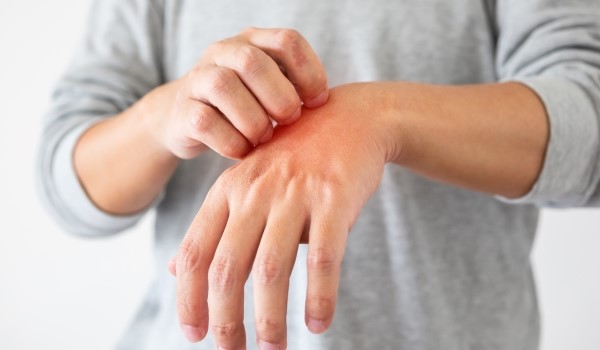What exactly is a
Pustular psoriasis?
Pustular psoriasis is a rare and severe form of psoriasis, a chronic inflammatory skin disease. It can persist long term and requires regular treatment to control symptoms and prevent possible complications. It is caused by an overactive immune response in which the immune system mistakenly attacks healthy skin cells, leading to an accelerated formation of skin cells.
Characteristic is the appearance of pustular blisters with purulent contents on the hands, feet, fingers and toes. The disease is often accompanied by severe itching and pain. In addition to the skin changes, those affected may also experience general symptoms such as fever, tiredness and malaise.
About the symptoms
More information
Important facts about pustular psoriasis
Symptoms and consequences of pustular psoriasis:
- Pustules: Pustular blisters with purulent contents on the skin
- Red, inflamed areas of skin around the pustules
- Itching and burning of the skin
- Pain in the affected skin areas
- Generally dry, flaky skin
- General symptoms such as fever, tiredness and malaise
- Reduced quality of life due to persistent symptoms
- Psychological stress, as skin changes are visible and those affected may feel self-conscious as a result
- Impaired mobility and hand function in affected hands and feet
What are the causes of pustular psoriasis?
As with other forms of psoriasis, it is assumed that a complex interaction of genetic, immunological and environmental factors contribute to the initial onset and progression of pustular psoriasis. The individual presentation and severity of the disease can vary, making treatment an individual challenge. An accurate diagnosis and appropriate treatment are therefore crucial.
What manifestations of pustular psoriasis are there?
The different manifestations of pustular psoriasis are characterized by the areas of skin affected and the severity of the pustules.
Generalized pustular psoriasis (psoriasis pustulosa generalisata)
A severe and widespread form in which large areas of skin appear on various parts of the body such as the hands, feet, legs and trunk. Can occur acutely or chronically and may be accompanied by fever, fatigue and malaise.
Acropustulosis (acrodermatitis suppurativa)
Rare form that mainly affects the fingers and toes. It is often accompanied by painful swelling and discoloration of the nails. The pustules can impair nail growth and lead to changes in the nail plate.
Palmoplantar pustulosis (palmoplantar psoriasis pustulosa)
In this form, the disease mainly manifests itself on the palms of the hands (palmar) and soles of the feet (plantar). It can be particularly painful and debilitating as it greatly affects the functions of the hands and feet.
Infantile pustular psoriasis (impetigo herpetiformis)
Rare form that can occur during pregnancy or in women of childbearing age. It often begins in the third trimester of pregnancy and is often accompanied by fever, tiredness and general malaise. Pustular psoriasis can lead to complications for mother and child in the event of pregnancy and therefore requires close monitoring and medical treatment.
Anular pustular psoriasis
Rare form with ring-shaped skin lesions. The pustules form along the edges of a ring and then gradually spread in a circular pattern. The center of the ring may have a smoother skin.
A severe and widespread form in which large areas of skin appear on various parts of the body such as the hands, feet, legs and trunk. Can occur acutely or chronically and may be accompanied by fever, fatigue and malaise.
Rare form that mainly affects the fingers and toes. It is often accompanied by painful swelling and discoloration of the nails. The pustules can impair nail growth and lead to changes in the nail plate.
In this form, the disease mainly manifests itself on the palms of the hands (palmar) and soles of the feet (plantar). It can be particularly painful and debilitating as it greatly affects the functions of the hands and feet.
Rare form that can occur during pregnancy or in women of childbearing age. It often begins in the third trimester of pregnancy and is often accompanied by fever, tiredness and general malaise. Pustular psoriasis can lead to complications for mother and child in the event of pregnancy and therefore requires close monitoring and medical treatment.
Rare form with ring-shaped skin lesions. The pustules form along the edges of a ring and then gradually spread in a circular pattern. The center of the ring may have a smoother skin.
How is pustular psoriasis diagnosed?
Following the general diagnosis of psoriasis, further examinations may be necessary to establish a differential diagnosis and distinguish pustular psoriasis from other forms. The diagnosis of pustular psoriasis can sometimes be challenging, as it is a rare form of psoriasis and its symptoms can overlap with other skin conditions. In such cases, the dermatologist may use additional laboratory tests or imaging techniques to support the diagnosis and develop the correct treatment strategy. In this way, an accurate diagnosis can be made, which is crucial to enable appropriate treatment and prevent possible complications.
Sources
Please note that all content provided regarding individual medical conditions, treatments, procedures, etc. is general information and may vary depending on the physician:in and individual case and initial situation.
For more detailed information, please always consult your doctor.
Deutscher Psoriasis Bund e.V.: Patient guideline for the treatment of psoriasis of the skin.
www.psoriasis-bund.dePlewig, G. et al: Braun-Falco's Dermatology, Venereology and Allergology (Volume 1). Springer-Verlag, 7th edition, 2018
P. Altmeyer: Impetigo herpetiformis. In: The online encyclopedia of dermatology, venereology, allergology and environmental medicine.
www.enzyklopaedie-dermatologie.deP. Altmeyer: Psoriasis pustulosa generalisata. In: The online encyclopedia of dermatology, venereology, allergology and environmental medicine.
www.enzyklopaedie-dermatologie.de